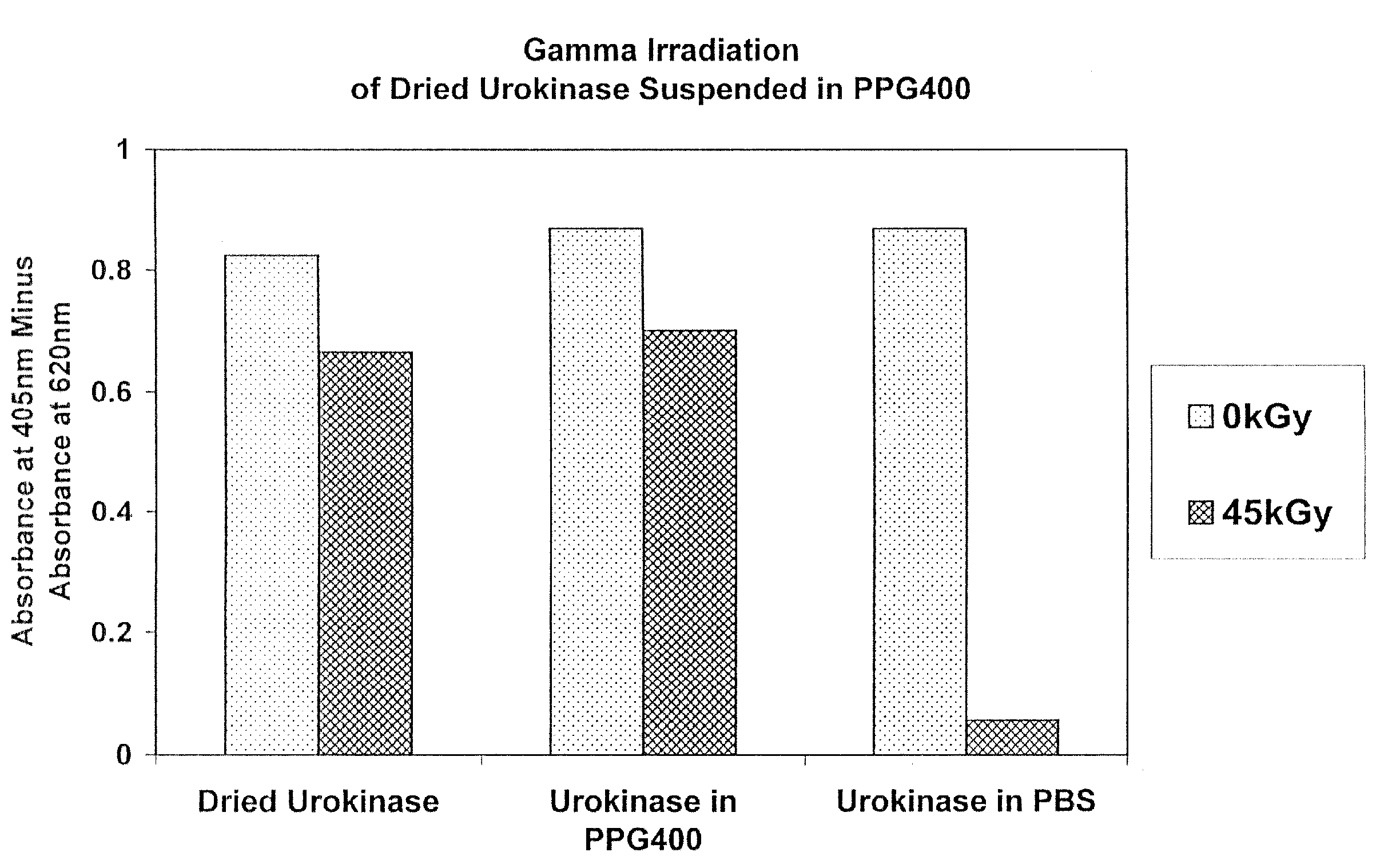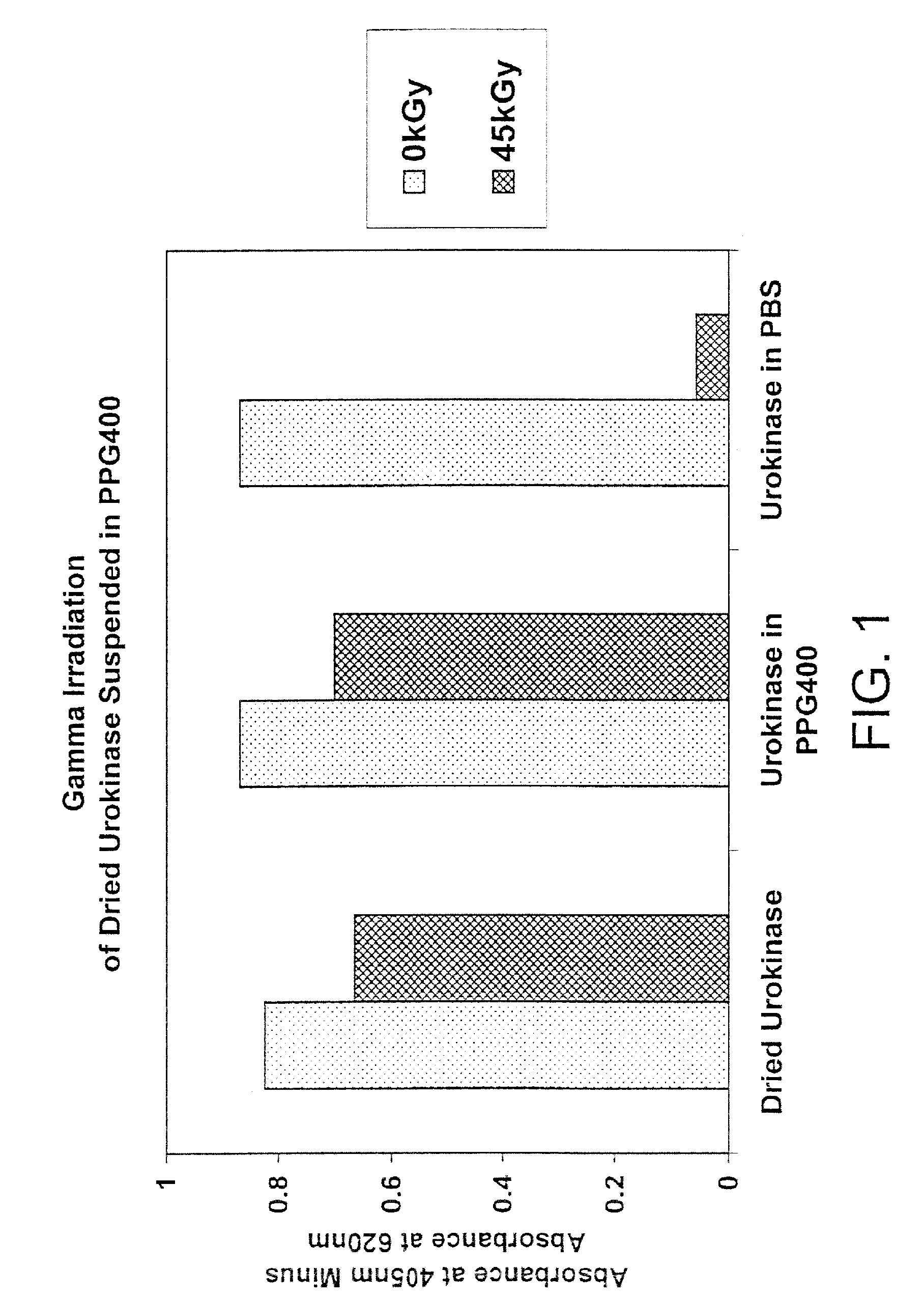Methods for sterilizing biological materials containing non-aqueous solvents
a technology of biological materials and solvents, applied in the field of methods for sterilizing biological materials, can solve the problems of not always reliable, inability to detect the presence of certain viruses, and unwanted and potentially dangerous biological contaminants or pathogens
- Summary
- Abstract
- Description
- Claims
- Application Information
AI Technical Summary
Benefits of technology
Problems solved by technology
Method used
Image
Examples
example 1
[0101]In this experiment, the effect of gamma radiation on dried urokinase suspended in polypropylene glycol (PPG) 400 or phosphate buffered saline (PBS) was determined.
Method
[0102]Six 1.5 ml polypropylene microfuge tubes containing urokinase and PPG400 (tubes 2 and 5), PBS (tubes 3 and 6) or dry urokinase alone (tubes 1 and 4) were prepared as indicated in the table below. Tubes 4-6 were gamma irradiated at 45 kGy (1.9 kGy / hr) at 4° C. Tubes 1-3 were controls (4° C.).
[0103]
weightof dryvolumeurokinasePPG400volumeTubeSample(mg)(ul)PBS (ul)1dry urokinase alone3.2002urokinase suspended in PPG4003.1612603urokinase suspended in PBS3.0801234dry urokinase alone3.38005urokinase suspended in PPG4003.313206urokinase suspended in PBS3.520141
[0104]After irradiation, the samples were centrifuged at room temperature for 5 minutes at 14 k RPM. PPG400 solvent was removed from tubes 2 and 5 and 120 μl PBS were added to those two tubes. 128 μl and 135 μl PBS were added to tubes 1 and 4, respectively ...
example 2
[0110]In this experiment, the activity (as shown by the ability to bind antigen) of immobilized anti-insulin monoclonal antibody was determined after irradiation in the presence of various forms of polypropylene glycol (molecular weights of 400, 1200 and 2000).
Method
[0111]In two 96-well microliter plates (falcon plates—ProBind polystyrene cat. # 353915), the wells were washed four times with full volume PBS (pH 7.4). Once the two plates were prepared as described above, they were coated with 100 μl / well of freshly prepared 2 μg / ml anti-insulin in coating buffer and left overnight at 4° C. The plates were then washed briefly three times with PBS (pH 7.4) and 100 μl of PPG400, PPG1200 or PPG2000 were added to specific wells. Each solution was prepared in a 11, i.e., 2-fold, dilution series with PBS. Both plates were covered tightly with a cap mat (Greiner cap mat cat. # 381070 (USA Scientific)) and irradiated at either 0 kGy / hr or 45 kGy (1.92 kGy / hr), both at 4° C.
[0112]Following irr...
example 3
[0126]In this experiment, liquid thrombin containing 50% glycerol and spiked with porcine parvovirus (PPV) was irradiated to varying total doses of radiation.
Method
[0127]1. Add 100 μl 100% glycerol, 20 μl thrombin (100 U / ml thrombin) spiked with 50 μl PPV and optionally 20 μl (200 mM) sodium ascorbate as a stabilizer (adjusted to a total volume of 1 ml with H2O) to Wheaton 3 ml tubes (in duplicate), and irradiate to a total dose of 10, 30 or 45 kGy at 1.8 kGy / hr at 4° C.[0128]2. Label and seed 96-well cell culture plates to allow at least 4 well per dilution (seeding to be done one day before inoculation). Add 200 μl of cell suspension per well at a concentration of 4×104 / ml. The same cell culture medium is used for cell growth and maintenance after virus inoculation.[0129]3. Perform virus inoculation when the cells sheets are 70-90% confluent. In this experiment 800 μl PK-13 growth media was added to 200 μl samples first.[0130]4. Make appropriate dilution (1:5) of samples with PK-1...
PUM
 Login to View More
Login to View More Abstract
Description
Claims
Application Information
 Login to View More
Login to View More - R&D
- Intellectual Property
- Life Sciences
- Materials
- Tech Scout
- Unparalleled Data Quality
- Higher Quality Content
- 60% Fewer Hallucinations
Browse by: Latest US Patents, China's latest patents, Technical Efficacy Thesaurus, Application Domain, Technology Topic, Popular Technical Reports.
© 2025 PatSnap. All rights reserved.Legal|Privacy policy|Modern Slavery Act Transparency Statement|Sitemap|About US| Contact US: help@patsnap.com



